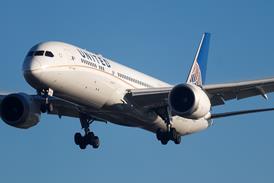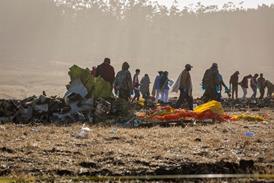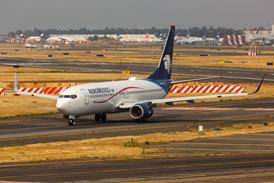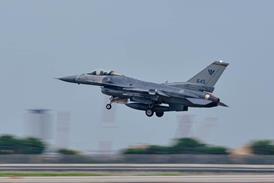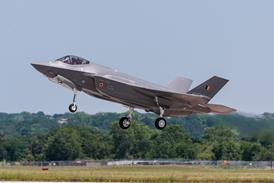BRENDAN SOBIE / SACHON, SOUTH KOREA
South Korea's KAI believes its versatile T-50 Golden Eagle supersonic trainer will lift it into the top 10 of aerospace exporters
Korea Aerospace Industries (KAI) is aiming to place South Korea on the map of top aircraft manufacturers by building a next-generation supersonic trainer it believes will thrive in a multitude of missions.
With the help of Lockheed Martin, KAI has developed the T-50 Golden Eagle and completed four aircraft that are being subjected to a rigorous three-year flight-test programme at Sachon in south-western Korea. The T-50, which had its maiden flight in August 2002 and exceeded Mach 1 for the first time in February 2003, is scheduled to enter service in October 2005.
The Golden Eagle is initially being developed for the South Korean air force as an advanced pilot trainer (APT) called the T-50 and a lead-in fighter trainer (LIFT) called the A-50. The air force plans to later use the A-50 for close-air-support (CAS) missions.
KAI is confident it will also eventually sell the aircraft to the air force as an F-50 fighter. Exports of all variants are already being pursued and are needed for KAI to meet its lofty goal of becoming a top 10 aerospace exporter.
KAI and partner Lockheed Martin are jointly marketing the aircraft worldwide and hope to start export deliveries in late 2006, but a launch deal does not appear to be imminent.
Tough market
Sceptics believe KAI will have a hard time competing against more established trainer manufacturers such as Aermacchi and BAE Systems. Selling a South Korean product, especially outside Asia, could be tough given that the country is a newcomer to the military aircraft export market.
But KAI says it is ready to become a global player, given its experience with licence-building Lockheed Martin F-16s and manufacturing its KT-1 primary trainer. Potential export customers are closely monitoring the air force's flight-test programme and KAI is confident they will adopt its high-end trainer for a multitude of missions once the T-50 proves its worth.
Development of the T-50 began in 1992 as the KTX-2. From the beginning, KAI predecessor company Samsung Aerospace targeted the high-end trainer market, believing there would be demand for a modern supersonic aircraft that could help air forces bridge the gap between outdated subsonic trainers and state-of-the-art fighters.
"When we started conceptual development, we started from the [Northrop] F-5," says Sachon aircraft development centre director Sung Sub Jang. "We compared 36 configurations and selected one."
KAI's goal was to offer the air force a replacement for its ageing advanced trainer fleet. South Korea uses BAE Systems Hawks, Northrop T-38s and F-5Bs for the APT and LIFT missions. But the air force believes this fleet fails to provide students with sufficient skills, forcing it to use a tactical wing to complete the training syllabus.
As a result, the T-50 was developed with a glass cockpit and digital fly-by-wire flight controls to mirror a fighter. By acquiring the T-50, the air force hopes to accelerate the learning curve, minimise transition time to fighters, reduce training costs and free tactical assets.
At the same time a single-seat fighter was also considered in the initial design phase. Therefore, three versions have always been planned - the T-50A for APT; the T-50B, later called the A-50, for LIFT and CAS; and the T-50C, now known as the F-50. While the concept of the F-50 is a decade old, this variant has not yet been sold and a conceptual design and feasibility study was only completed last year.
"We designed the A-50 first and then the T-50 because the A-50 is more critical," Jang says. The final design was selected at the end of 1994 and the preliminary design review was completed in August 1999.
Speed and climb
The Golden Eagle is designed for a maximum speed of Mach 1.5, with a ceiling of 55,000ft (16,800m) and a maximum range of up to 1,850km (1,000nm). It can take off in 345m (1,130ft) at a gross weight of up to 13,500kg (29,700lb) and climb at 39,600ft/min (200m/s). The aircraft can land in 2,320ft of runway in a crosswindof up to 25kt (45km/h).
KAI says the aircraft could have been built to fly at M1.7, but it opted for a lower-speed wing design to improve the aircraft's handling qualities.
The T-50's control surfaces are composite, but otherwise the aircraft is manufactured from aluminium alloy with some titanium used where required. KAI considered composite landing gear doors and speed brakes but decided to stick with aluminium alloy for these components as well.
"For composites, you need more budget," says Jang. "We didn't think it was appropriate for this programme. If we badly need weight savings for a derivative, or even for flight operations, we can change."
Design highlights include a variable-camber wing, a blended wing-fuselage and horizontal and vertical control surfaces that are sized for fighter-like performance.
KAI opted for a single engine configuration to keep life-cycle costs down. Jang says a twin-engined configuration would have been 10% bigger and cost 30% more.
Proven powerplant
South Korea also decided against developing an indigenous engine and opted for the General Electric F404-102. The F404 was chosen because it is a proven powerplant, with over 10 million flight hours on nine aircraft types, and offered full-authority digital engine control (FADEC). The engine provides 17,700lb of thrust (79kN) at a thrust-to-weight ratio of 0.91 and a bypass ratio of 0.27.
Jang says KAI is open to later modifying the T-50 design to accommodate a second engine at the request of a customer. "Twin engine is something we can consider later," he says.
The fuel system includes seven internal tanks, five in the fuselage and two in the wings, providing 2,655 litres (700USgal) or 2,220kg of capacity. Three 570 litre external fuel tanks can also be carried.
KAI has designed a dual engine-feed system to ensure uninterrupted fuel supply. Fuel quantity is displayed digitally in the cockpit. The company has also designed a dual 207bar (3,000lb/in2) hydraulic system with an emergency back-up pump connected to the auxiliary power supply. The electrical system consists of three 100 Amp DC converters and a 500W emergency battery converter, providing 30-40kVA of power in the primary mode and 7kVA in the emergency mode.
Hamilton Sundstrand is supplying an auxiliary power system capable of supporting self-starts both on the ground and in the air. Engine airstarts will be cleared for up to 20,000ft. Hamilton Sundstrand has also integrated a thermal battery and auxiliary power unit generator to provide emergency power.
Lockheed Martin assumed the lead role in developing and integrating the fighter-like digital fly-by-wire flight control system. This features a digital flight control computer, an air data system with three integrated multifunction probes and integrated active stick technology that allows an instructor to override student inputs. Like a fighter, the cockpit gives pilots a wide field of view through a head-up display as well as hands on throttle and stick controls.
KAI and Lockheed Martin aimed to incorporate the most modern commercial off-the-shelf equipment in selecting avionics vendors. Lockheed Martin took the lead in selecting the computers and displays, while KAI selected most of the other equipment.
BAE was chosen to supply the integrated mission display computer; APX-118 identification friend or foe with interface to a traffic collision avoidance system; wide field-of-view head-up display; colour cockpit television system; and integrated up-front control.
Honeywell was selected to provide the colour multifunction displays; H-764G embedded global positioning/inertial navigation system; and HG9550 radar altimeter. Rockwell Collins is supplying the VIR-130A integrated VOR/instrument landing system and ARN-153V advanced digital tactical aid to navigation.
Data transfer
The UK's Smiths Aerospace is providing the advanced data transfer equipment and airborne video solid-state recorder. Raytheon is supplying the ARC-232 VHF radios, Sanmina-SCI the intercom system and Dynamic Controls the stores management system.
The avionics architecture is designed to be fully integrated, common to fighters and expandable. Equipment can easily be swapped to meet export customer requirements.
KAI has intentionally left room for growth, realising a more advanced fighter variant could be on the cards. In the future, South Korea also aims to indigenously develop and manufacture some of the cockpit equipment as part of an attempt to bolster its fledgling avionics industry.
The flight control system is triple redundant, meaning the T-50 can endure up to two system failures and complete the mission. But the air force policy is to continue missions following a single failure but return to base if there is a double failure.
"Technically, quadruple is safer, but nowadays technology is better, so triple is safe enough," says T-50 research engineer Sangdawn Kim.
The stall speed is 105kt. But the aircraft cannot be conventionally stalled because of an angle of attack (AoA) limiter. The limiter prevents students from exceeding a 25° AoA, although an AoA as high as 33° can be sustained while maintaining stable flight. There is also an anti-spin system, providing yet another layer of protection against a stall.
The T-50's mishap rate is intended to be no more than one per 100,000 flight hours. The ejection seat, supplied by Martin Baker, can be used at up to 600kt.
The aircraft is designed to have a service life of 10,000h. The estimated mean time between failures is 6.43h and 5.14 maintenance man hours will be required per flight hour. Design mean time to repair is 1.46h and the average engine installation time is one hour. The T-50 can be turned around in just under 20min.
The aircraft has a smart system to inform the operator when maintenance is required. As a result, periodic depot maintenance does not have to be scheduled, KAI says.
Tandem seats
Inside, tandem seats can accommodate students and instructors weighing between 53kg and 99kg each. An onboard oxygen generating system is available and the cockpit is cooled by an environmental control system featuring a 12kW-capacity air-bearing turbine.
Most of the T-50's major structures are being manufactured locally, although the landing gear is being sourced from Messier Dowty. KAI's Sachon plant has a dedicated component manufacturing building, which is in charge of fabricating several T-50 parts, including the vertical fin; forward, centre and aft fuselage; engine doors; speed brakes; vertical fin leading edges; cockpit panels; fuel tanks; canopy; and horizontal stabiliser.
Another plant in Changwon, east of Sachon, is manufacturing the wing box, leading-edge seals and flaps, wing flaperons and wing fuselage fairings. Changwon was also chosen last year to produce the T-50 wing, which originally was going to be supplied by Lockheed Martin.
Sachon's flight sciences building is home to the T-50's avionics, flight control and aerodynamics teams. It houses over 150 employees, plus a handling-qualities simulator and avionics hot bench. Every flight-test sortie is rehearsed here before it is executed. Final assembly takes place in building 1 at Sachon, where KF-16s, Boeing F-15K wings and Boeing AH-64 Apache fuselages are also assembled.
Overall, Sachon has 1,900 employees. Roughly two-thirds, including 900 engineers, are assigned to the T-50. Around another 250 employees will be transferred to the T-50 after F-16 production concludes later this year. "F-16 production ends in June and we can use the space for the T-50," says Sachon plant manager and director No Sun Park.
Behind the assembly building are six hangars abutting a taxiway that leads to the Sachon airport's only runway. All four of the T-50 test aircraft are kept here.
A team of 37 air force pilots and personnel are stationed at Sachon to oversee T-50 flight testing and development (FTD). Also in the flight-test team are 12 KAI employees. There are no Lockheed Martin test pilots at Sachon, but they advise the team from Fort Worth, Texas, where there is also a handling-qualities simulator and avionics hot bench. The US company, having completed the basic software development, is now helping KAI test the avionics on the prototype aircraft and refine the software where required.
The flight-test team is required to complete 1,100 sorties before the FTD phase concludes in August 2005. The four prototype aircraft have 90% commonality with the production aircraft and are equipped with flight-test instrumentations.
The first prototype, flying since August 2002, is being tested in the clean configuration and being subjected to engine air restarts. The second aircraft, a T-50 prototype flying since November 2002, is focused on high-angle-of-attack tests.
The third and fourth aircraft, in A-50 configuration, began flying in September 2003. The third aircraft will be used mainly for weapon tests and weapon envelope expansion. So far only dummy stores have been used, but weapon releases are to begin later this year.
The fourth aircraft has initially been used to test the communication, navigation and identification equipment. Starting later this year it will focus on avionics, radar and weapon tests.
The first maximum-speed test is scheduled for June. Hot weather tests will be done at Sachon in July, allowing for full envelope clearance. In-flight gun firing tests will begin in September and cold weather tests will be conducted in January 2005 in the northern part of South Korea.
Missile launches
Raytheon AIM-9 Sidewinder short-range air-to-air missile launches will begin in March 2005 and Raytheon AGM-65 Maverick air-to-surface missile launches in April 2005. Mk82 bomb delivery accuracy tests are scheduled for May 2005. Live weapon testing will be conducted at an air force range off South Korea's west coast.
In June 2004, South Korea's Agency for Defence Development (ADD) plans to complete testing of the fatigue article. Last April the ADD finished one life-cycle, or 10,000h, and is in the middle of a second life. At the Korea Aerospace Research Institute, the static article has already been tested to ultimate load.
Initial operational capability is set for 2005 and full operational capability in 2011. Initial combat readiness was achieved last September and full combat readiness will be completed in 2006. South Korea's Defence Quality Assurance Agency (DQAA) is in charge of certifying the T-50 and deeming it combat ready.
The DQAA's initial combat readiness decision led to the award of an initial production contract late last year for 25 aircraft. A contract for an additional 69 aircraft is expected to be awarded after full combat readiness is achieved.
The initial 25 aircraft will all be T-50s for APT. The remaining 69 aircraft include another 25 T-50s and 44 A-50s. Half the A-50s will be used for LIFT, replacing F-5Bs from 2008. The other half will be used for CAS, replacing Cessna A-37s from 2011.
Equipment added to the A-50 variant only includes an internal 20mm gun, training stores carriage and a multimode radar. Lockheed Martin is supplying an upgraded version of its APG-67 radar. General Dynamics is making the gun.
The A-50 has a total 4,540kg store capability across seven stations. Air-to-air weapons planned include the AIM-9 missile. Air-to-ground weapons include the AGM-65, CBU-58 cluster bomb, laser-guided GBU-12, LAU-3/68/88/117/131, MAU-12/50, Mk20/82/83/84 dumb bombs, and SUU-20 gun pod. KAI is also offering an electronic warfare option for the A-50. The air force initially decided not to take this option but is again reviewing the requirement for its CAS A-50s.
The A-50 will enhance the air force's CAS capability because the A-37 does not have radar or GPS and can only carry 225kg of bombs. "The A-37 is not a capable aircraft," Jang says. "But the air force is seeing we may need more equipment in the A-50 if we're serious about close air-support."
The air force is considering adding a self-protection capability to the A-50. KAI is offering a radar warning receiver, countermeasures dispenser and onboard inert-gas generation system. A reconnaissance pod is another option, although this is not being considered by South Korea because the air force has instead opted to install pods on F-16s.
"When we started the development programme they [the air force] didn't believe what we could achieve so they didn't consider the details. Now the customer realises this is a serious aircraft they can use for serious missions," says Jang.
Last year KAI completed a conceptual design and feasibility study on the proposed single-seat F-50 and concluded only minor modifications would be needed beyond the A-50. KAI also concluded that several more advanced weapon systems can easily be incorporated, including AIM-7 Sparrow and AIM-120 AMRAAM missiles for air-to-air and AGM-158 JASSM, AGM-84H SLAM-ER, AGM-88 HARM, AGM-84 Harpoon and Popeye for air-to-ground. "It's simple," Jang says. "We don't change the engine. We don't change the landing gear. We're just upgrading the radar and cockpit."
Beyond visual range
The APG-67 on the F-50 would have beyond visual-range capability, compared with within visual-range capability on the A-50. A third colour multi-function display (CMFD) will also be installed, compared with two on the T-50 and A-50. KAI plans to change the seat height and canopy to give the pilot rear-view visibility. The removal of a seat also provides extra weight for fuel and weapons. In addition to missiles, the F-50 will be able to accommodate electronic countermeasures, reconnaissance pods, external fuel tanks, rockets, gun pods and guided weapons. A refuelling probe will be an option.
KAI hopes initially to sell the F-50 as a replacement for the South Korean air force's fleet of over 100 F-5s. Jang estimates the F-50 will be 10 times more effective in combat missions than the F-5, and even the A-50 offers a fivefold improvement.
"Our air force has ageing aircraft that will need replacing," Jang says. "But there is no alternative. We think this is the only alternative when you consider cost versus capability. This is probably good enough performance to replace some old F-16s too. This will be almost as capable as an F-16."
All three variants of the T-50 will enjoy 85% parts commonality with the F-16. The two aircraft have the same wing span and the T-50's volume is only about 10% less.
Performance-wise, the T-50 can reach 30,000ft in 102.2s, compared with 81.4s for the F-16. KAI claims other advanced trainers take between 190s and 500s to reach this altitude.
The T-50 and F-16 have a similar cockpit, including the radar, side stick, throttle and autopilot. Externally, the two aircraft use the same amount of composite materials.
KAI believes its experience manufacturing 140 F-16s over the last decade gives it ample experience to build its own trainer and fighter. At the height of KAI's F-16 programme, 500 of its employees, including 450 production mechanics, were assigned to the F-16 line.
"The manufacturing philosophy is very similar," says Lockheed Martin T-50 programme director Charles Smith, who has since retired and been replaced by former deputy programme director Gary Keith. "The manufacturer know-how is directly applicable to any fighter aircraft."
KAI's Kim adds: "The F-16 is our competitor. The F-5 is obsolete." But for now KAI is not trying to trying to sell the T-50 against the F-16. Instead the KAI-Lockheed Martin joint international marketing team is mainly pitching the proposed F-50 variant as a replacement for F-5s and McDonnell Douglas F-4s for air forces worldwide.
By combining the F-50 with the T-50 and A-50, a swing-role aircraft is being offered to potential operators, providing a mix of training, fighter and attack capabilities. Such an aircraft could especially be a cost-effective option for militaries that do not have the budget to purchase more advanced fighters.
"The [2,600-aircraft] F-5 replacement market is very interesting," says Lockheed Martin's T-50 international senior marketing director Robie Notestine. "Our market analysis shows we can probably capture that market with the F-50. The A-50 will make a nice attack aircraft. The F-50 will make things real interesting."
KAI wants to begin developing the F-50 this year because 600 of its engineers are wrapping up development work on the T-50/A-50 and a new project is required to keep them occupied. "We have engineers in design we need to utilise. We need theF-50 or any export derivative, the T-50X or T-50Y," Jang says.
The T-50X and T-50Y are potential variants for Israel and the USA. KAI has also proposed a T-50U to the United Arab Emirates. An export variant of the T-50 would add a third CMFD and customer specific equipment.
Most of the potential export customers use embedded or virtual training, so they will not need the radars and guns required by the Korean air force, which prefers hardware-based training. KAI is also open to making special workshare arrangements for export customers.
KAI is confident it can outsell the competition because most of its competitors, including the Aermacchi M346 and the Hawk, are subsonic and have "outdated" cockpits. KAI sees the biggest threat coming from the new supersonic EADS Mako, but believes the T-50 entering into service several years earlier will give it an advantage. All the competing aircraft cost about $20 million apiece.
KAI plans to begin offering prospective customers and their test pilots T-50 demonstration flights later this year. But none of the prospective customers are expected to select a new-generation trainer until at least next year.
KAI and Lockheed Martin are now focusing mainly on the Middle East and, to a lesser extent, Asia and Europe. A potential export to the USA is at least a decade away because the US Air Force is upgrading its fleet of T-38s and a replacement will not be required until about 2015. "At some point we think it's an excellent replacement for T-38s," says Smith.
Global market
Overall, Lockheed Martin estimates a global market of 300-600 advanced trainers over the next 20 years. The company is banking on international sales to recoup its 13% investment in the T-50, while KAI and the South Korean government have even more at stake, with investments of 17% and 70%, respectively.
"We think there's a good chance of signing a launch customer in 2006, but the market really gets interesting in the 2008-9 timeframe," says Notestine. "Air force resources around the world will start getting worn out at that time."
Notestine, Lockheed Martin's only dedicated T-50 salesman, works with KAI's 11-man Seoul-based T-50/KT-1 marketing team. He also co-ordinates with Lockheed Martin's regional marketing team, which has about 35 members spread across the world that cover the company's entire product line.
"We're jointly marketing it around the world," Smith says. "We're marketing it as a Lockheed Martin product just like our other products."
Lockheed's main responsibility for the T-50 is shifting to marketing as the development phase of the programme begins to wind down. Lockheed's involvement in the production phase was reduced to only technical support last year after it agreed to shift wing production from Fort Worth to Changwon in an effort to curb costs.
At the height of T-50 development, Lockheed Martin dedicated 300 employees at its Fort Worth plant to the programme and had another 80 employees working from Sachon. Close to 100 KAI engineers were also dispatched to Texas during peak development.
Today there are still clocks throughout the Sachon plant displaying Fort Worth time and a dedicated video conference line connecting the two factories. But only about 160 Lockheed Martin employees remain assigned to the T-50, including 130 at Fort Worth and 30 at Sachon, and this will dwindle further over the last two years of the FTD phase.
"The majority of deliverables for FTD have been done. The wings are done. The avionics are done. So we'll be decreasing that [headcount] over the next two years," Smith says.
In helping KAI develop the T-50, Lockheed Martin took a similar approach to the Indigenous Defence Fighter (IDF), built until 1999 by Taiwan's Aerospace Industrial Development Corporation (AIDC). Smith says the T-50's avionics architecture is similar to that of the IDF, with some upgrades. In addition, many of the Lockheed Martin engineers which worked with AIDC on the IDF programme were later used for the T-50.
"The T-50 is similar to what we've done on other platforms," Smith says. "Some has been borrowed from the F-16 and some from the IDF."
Source: Flight International

